
Horiba LAQUAtwin EC-33 Pocket Water Quality Meters Sigmatech Inc. Philippines
HORIBA’s unique compact meter integrates the electrode, display and sample container to enable simple, effective on-site testing by direct measurement from a single drop.

The modern FE-SEM requires not only high performance but also a multitude of functionalities including wide-area observation, in-situ analysis, variable pressure, high-resolution imaging at low accelerating voltages, and simultaneous multi-signal collection.
The SU7000 is designed to address these aspects and more by delivering enhanced information for diversified needs in the field of electron microscopy.
The advanced detection system of the SU7000 streamlines acquisition of structural, topographical, compositional, crystallographic, and other types of information by minimizing changes to microscope conditions, such as working distance or accelerating voltage.
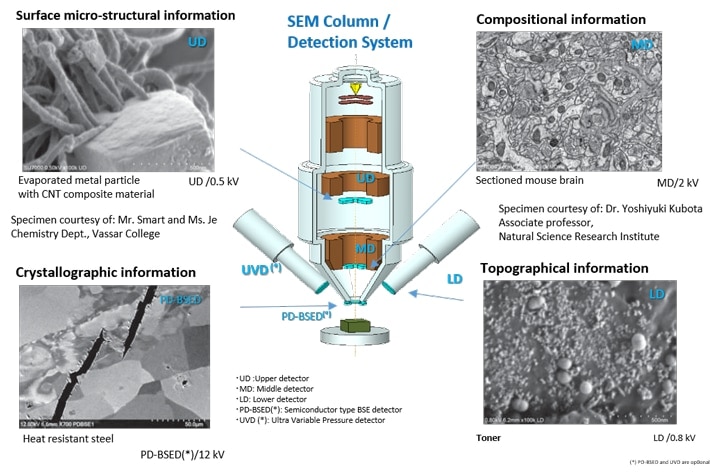
Specimen: Organic-coated gold rods
Specimen courtesy of: Mr. Smart and Ms. Je Chemistry Dept.,
Vassar College

Simultaneous image acquisition for surface micro-structural information (UD), surface coating (MD), and overall topographic information (LD). Acceleration voltage: 1 kV
The software is capable of display 1, 2, or 4 signals including the chamber scope or SEM MAP on a single monitor.
Additionally, the operation panel can be customized to display submenus anywhere on the screen.
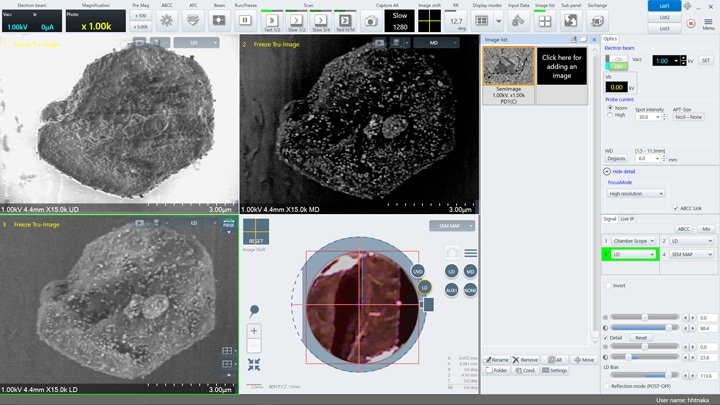
The first monitor can be used as a dedicated image display while the second monitor is utilized for operation.
Five detector images (UD, LD, UVD, MD, and PD-BSED) and SEM MAP of non-metallic inclusions in a steel specimen are displayed (left).
The screen shows the operation panel menu and the thumbnail image window on one screen (right).
The dual-monitor configuration supports increased productivity with expanded workspace.
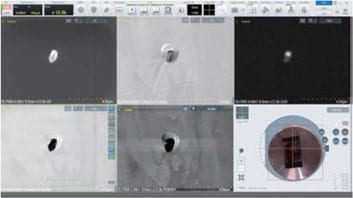
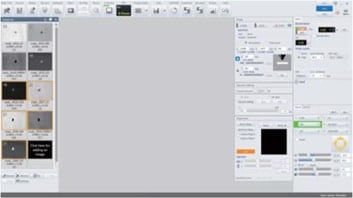
The specimen chamber can accommodate a tall specimen of φ 200 mm or 80 mm in height and 18 accessory ports. The large stage travels 135 mm (X) x 100 mm (Y) and can accept up to 2 kg of specimen.(*) Large specimen or variable type of sub-stages can be easily mounted on the front-opening large stage door.
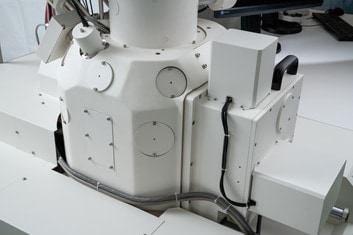
external view of the specimen chamber featuring 18 accessories ports
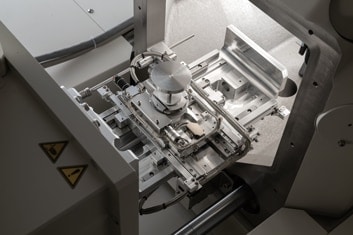
external view of the stage. XY movable range: 135×100 mm

Left: Picture of the sample captured by the camera equipped inside the chamber.
Right: Camera image transferred to the SEM MAP screen for navigation.
The camera navigation feature correlates an optical image to the target observation area.
The camera installed in the specimen chamber captures the specimen image at the time of specimen introduction. The image is transferred to the SEM MAP screen for a graphically driven navigation interface.
Camera navigation supports a maximum of φ 100 mm specimen.
The SU7000 supports observation under various environmental conditions. A variety of detectors (*) such as UVD and MD are selectable in addition to the PD-BSED for observation under low-vacuum conditions.
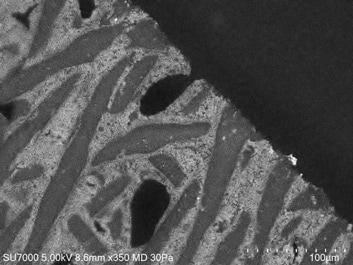
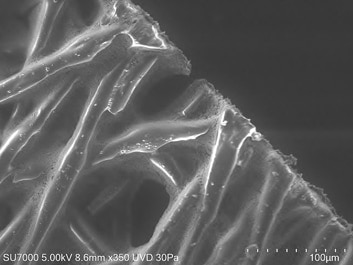
Detector Selection Under Low-Vacuum Conditions
Specimen: Fiber with metallic oxide
Left: MD (Backscattered electron) image
Right: UVD (SE image)
The oxide dispersion and fiber layering state are observed respectively.
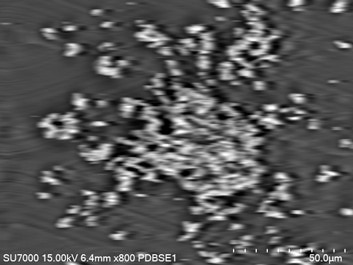
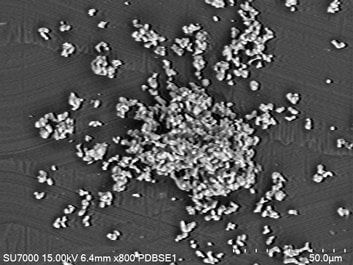
Improved PD-BSED Response Speed
Left: Traditional PD-BSED response at the scan rate of 30 ms x 64 frames
Right: SU7000 PD-BSED image demonstrating improved response and image quality to expand in-situ observation capability
| Image Resolution | Resolution SE | 0.8 nm@15 kV | |
|---|---|---|---|
| 0.9 nm@1 kV | |||
| Magnification | 20~2,000,000 x | ||
| Electron Optics | Emitter | ZrO/W Schottky Emitter | |
| Accelerating Voltage | 0.1~30 kV (0.01 kV step) | ||
| Probe Current | Max. 200 nA | ||
| Detectors | Standard Detectors | UD(Upper Detector) | |
| MD(Middle Detector) | |||
| LD(Lower Detector) | |||
| Optional Detectors | PD-BSED(Semiconductor type) | ||
| UVD (Ultra Variable Pressure Detector) | |||
| Variable Pressure(VP) Mode (Option) | Pressure Range | 5~300 Pa | |
| Available Detectors in VP mode | PD-BSED, UVD, UD, MD,LD | ||
| Specimen Stage | Stage Control | 5-axis Motor Drive | |
| Movable Range | X | 0~135 mm | |
| Y | 0~100 mm | ||
| Z | 1.5~40 mm | ||
| T | -5~70° | ||
| R | 360° | ||
| Specimen Chamber | Specimen Size | Max. φ200 mm, Max. 80mm Height | |
| Monitor(Option) | 23 inch LCD(1,920×1,080) , supports dual monitors operation | ||
| Image Display Mode | Large Screen Display Mode | 1,280×960 pixels | |
| Single Image Display Mode | 800×600 pixels | ||
| Dual Image Display Mode | 800×600 pixels、1,280×960 pixels with dual monitors | ||
| Quad Image Display Mode | 640×480 pixels | ||
| Hex Image Display Mode w/dual monitors | 640×480 pixels with dual monitors | ||
| Image Data Saving | Pixel Size | 640×480、1,280×960、2,560×1,920、5,120×3,840、10,240×7,680 | |
| Optional Accessories | Energy Dispersive X-ray Spectrometer (EDX) | ||
| Wavelength Dispersive X-ray Spectrometer (WDX) | |||
| Electron Backscattered Diffraction Detector (EBSD) | |||
| Cathodoluminescence System (CL) | |||
| Cryogenic Transfer System | |||
| Compatible with various types of sub-stages | |||
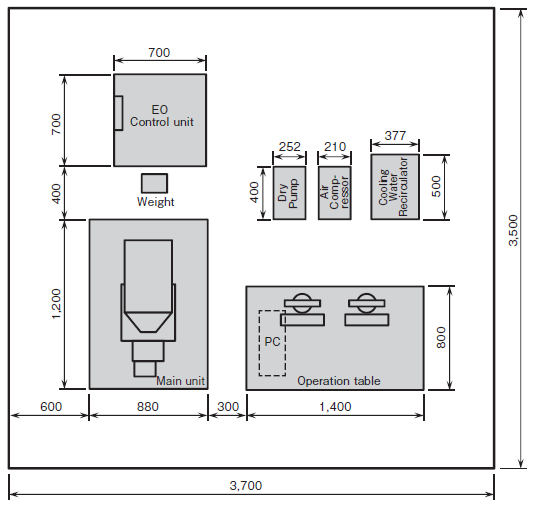

HORIBA’s unique compact meter integrates the electrode, display and sample container to enable simple, effective on-site testing by direct measurement from a single drop.

ULTRAPOL End & Edge Polisher has been designed to provide accurate lapping and polishing for research and industrial applications. Several thousand of these units are already assisting users in a wide range of technical disciplines.

ULVAC-PHI nanoTOF II™ is a state-of-the-art TOF-SIMS with wide variety of options to choose from depending on the customer’s application.

The Lazer 200 is an innovative non-contact measuring system that uses laser scanning and video support for surface topography measurements.


Cobra™ Laser Profiling systems from OGP use low-power laser lights to measure height, area, slope, and radius. These laser profilers are ideal for a variety of applications where non-contact measurement is critical to ensure integrity for your parts while measuring to precise accuracies.
You may contact our specialists by accomplishing form below.
You may contact our specialists by accomplishing form below.